Astronomy:List of supernova remnants
From HandWiki
Short description: none
This is a list of observed supernova remnants (SNRs) in the Milky Way, as well as galaxies nearby enough to resolve individual nebulae, such as the Large and Small Magellanic Clouds and the Andromeda Galaxy.
Supernova remnants typically only survive for a few tens of thousands of years, making all known SNRs fairly young compared to many other astronomical objects.
| Image | Name | Right ascension | Declination | First visible from Earth |
Peak magnitude |
Distance (ly) | Type | Remnant |
|---|---|---|---|---|---|---|---|---|
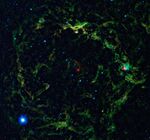
|
Sh2-264 or Lambda Orionis Ring |
05h 37m | +09° 30′ | -1000000~1 million years ago | ? | 1,100 | ? | ? |
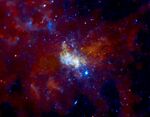
|
Sagittarius A East | 17h 45m 41s | −29° 00′ 48″ | -70000100,000−35,000 years ago |
? | 26,000 | tidal disruption | ? |

|
Simeis 147 or Spaghetti Nebula |
05h 39m | +27° 50′ | -40000~40,000 years ago | 6.5 | 3,000 | ? | neutron star PSR J0538+2817 |
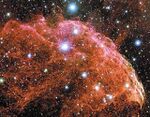
|
IC 443 also known as jellyfish nebulae | 06h 18m 02.7s | +22° 39′ 36″ | -30000~30,000 years ago | ? | 3,000 | II | neutron star CXOU J061705.3+222127 |
| SNR G132.6+01.5 | 02h 17m 40s | +62° 45′ 00″ | -3000033,000-27,000 years ago | ? | 7,200 | ? | ? | |

|
W50 or Manatee Nebula |
19h 12m 20s | +04° 55′ 00″ | -20000~20,000 years ago | ? | 18,000 | ? | black hole/neutron star SS 433 |

|
W44 | 18h 56m 10.65s | +01° 13′ 21.3″ | -1800020,000-16,000 years ago |
? | 10,400 | ? | neutron star PSR B1853+01 |
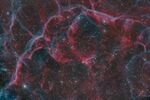
|
Vela SNR | 08h 34m | −45° 50′ | -1030010,300−9,000 BCE | 12 | 815±98 | II | neutron star Vela Pulsar |
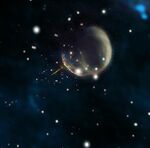
|
CTB 1 or Abell 85 |
23h 59m 13s | +62° 26′ 12″ | -90009,000-5,500 BCE | ? | 10,100 | ? | neutron star PSR J0002+6216 |
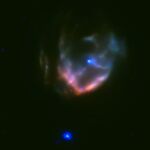
|
Kesteven 79 | 18h 52m 29s | +00° 38′ 42″ | -86008600–7000 BCE | ? | 23,000 | ? | neutron star PSR J1852+0040 |
 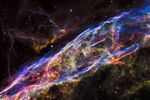
|
Cygnus Loop, including Veil Nebula |
20h 51m | +30° 40′ | -45006,000−3,000 BCE | 7 | 1,470 | ? | possible neutron star 2XMM J204920.2+290106 |

|
3C 58 | 02h 05m 37.0s | +64° 49′ 42″ | -40003500−1500 BCE | ? | 8,000 | ? | pulsar 3C 58 |
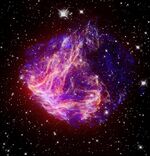
|
LMC N49 | 05h 26m 00.4s | −66° 05′ 02″ | -3000~3,000 BCE | ? | 160,000 | ? | neutron star PSR B0525-66 |
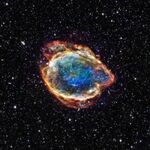
|
G299.2-2.9[1] | 12h 15m 13s | −65° 30′ 00″ | -2500~2,500 BCE | ? | 16,000 | Ias | none |
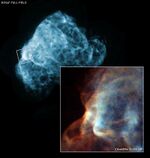
|
Puppis A | 08h 24m 07s | −42° 59′ 50″ | -1700~1,700 BCE | ? | 7,000 | ? | neutron star RX J0822−4300 |
| G332.4+00.1 | 16h 15m 20s | −50° 42′ 00″ | -1000~1,000 BCE | ? | 16,800 | ? | neutron star PSR J1614-5048 | |
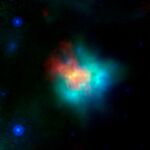
|
G54.1+0.3[2] | 19h 30m 30s | +18° 52′ 14″ | -900~900 BCE | ? | 22,000 | ? | neutron star PSR J1930+1852 |

|
G292.0+01.8 | 11h 24m 59s | −59° 19′ 10″ | -600~800-400 BCE | ? | 17,600 | ? | neutron star PSR J1124-5916 |
| Kesteven 75 | 18h 46m 25.5s | −02° 59′ 14″ | -1001st millennium BCE | ? | 18,900 | ? | neutron star PSR J1846-0258 | |

|
G306.3-0.9[3] | 13h 21m 50.9s | −63° 33′ 50″ | -400~400 BCE | ? | 26,000 | Ia | none |
| File:RCW103.tif | RCW 103 | 16h 17m 33s | −51° 02′ 00″ | 501st century | ? | 10,000 | II | neutron star 1E 161348-5055 |
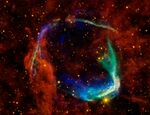
|
SN 185 | 14h 43m 00s | −62° 30′ 00″ | December 7, 185 | ? | 8,200 | Ia | none |
| CTB 37B (possibly SN 393) |
17h 13m 43.0s | −38° 10′ 12″ | 500~500 CE (April 393?) |
? | 43,000 | ? | neutron star CXOU J171405.7-381031 | |
| File:Tour of E0102.OGG | E0102 | 01h 04m 01s | −72° 01′ 52″ | 5001st millennium | ? | 190,000 | ? | neutron star |
| SNR 0540-69.3 | 05h 40m 10.8s | −69° 19′ 54.2″ | 800350-1250 CE | ? | 160,000 | ? | neutron star PSR J0540−6919 | |
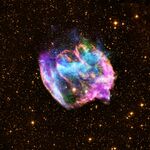
|
W49B | 19h 11m 09s | +09° 06′ 24″ | 1000About 1000 CE | ? | 26,000 | Ib or Ic | unidentified black hole |
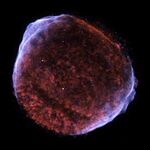
|
SN 1006 | 15h 02m 22.1s | −42° 05′ 49″ | May 1, 1006 | −7.5 | 7,200 | Ia[4] | none |

|
G350.1-0.3 | 17h 21m 06s | −37° 26′ 50″ | 10501000-1100 | ? | 15,000 | ? | neutron star XMMU J172054.5-372652 |

|
SN 1054 or M1 or Crab Nebula |
05h 34m 31.94s | +22° 00′ 52.2″ | July 4, 1054 | −6 | 6,300 | II | neutron star Crab Pulsar |
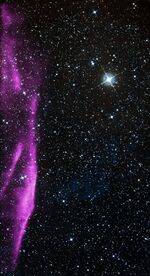
|
RX J0852.0-4622 or Vela Junior |
08h 52m 00s | −46° 20′ 00″ | 1250September 13, 1271[5] | ? | 700 | ? | neutron star CXOU J085201.4–461753 |
| SGR 1806-20 | 18h 08m 39.32s | −20° 24′ 40.1″ | 13501050-1650 | ? | 42,000 | ? | neutron star SGR 1806-20 | |

|
SN 1572 or Tycho's Nova |
00h 25m 21.5s | +64° 08′ 27″ | November 11, 1572 | −4 | 7,500 | Ia[4] | none |
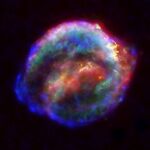
|
SN 1604 or Kepler's Nova |
17h 30m 35.98s | −21° 28′ 56.2″ | October 8, 1604 | −2.5 | 20,000 | Ia | none |

|
Cassiopeia A | 23h 23m 24s | +58° 48′ 54″ | 1667circa 1667 | 6 | 10,000 | IIb[6] | neutron star CXOU J232327.8+584842 |
| SN 1885A or S Andromedae |
00h 42m 43.12s | +41° 16′ 03.2″ | August 20, 1885 | 6 | 2,500,000 | I pec | none | |
| File:G19 xray.tif | G1.9+0.3 | 17h 48m 46.1s | −27° 09′ 50.9″ | 1898circa 1898 | ? | 25,000 | Ia | none |
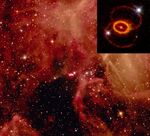
|
SN 1987A | 05h 35m 28.02s | −69° 16′ 11.1″ | February 24, 1987 | 3 | 168,000 | II-P | neutron star |
See also
References
- ↑ Chandra X-Ray Observatory (2015-02-12). "G299.2-2.9: Exploded Star Blooms Like a Cosmic Flower". http://chandra.harvard.edu/photo/2015/g299/.
- ↑ J. Rho et al. (2017), "A Dust Twin of Cas A: Cool Dust and 21-micron Silicate Dust Feature in the Supernova Remnant G54.1+0.3", MNRAS doi:10.1093/mnras/sty1713
- ↑ Francis, Reddy. "NASA's Swift, Chandra Explore a Youthful 'Star Wreck'". NASA. http://www.nasa.gov/mission_pages/swift/bursts/star-wreck.html.
- ↑ 4.0 4.1 Schaefer, B. E. (2004). Cosmic explosions in three dimensions : asymmetries in supernovae and gamma-ray bursts. Cambridge Contemporary Astrophysics. p. 383. ISBN 0-521-84286-7. http://www.cambridge.org/series/sSeries.asp?code=CCA.. Supernovae types discussed in contributed article "Types for the galactic supernovae" by B.E. Schaefer, pp. 81–84.
- ↑ Polynesian origins of the Maori in New Zealand and the supernova RX J0852.0-4622. February 2019. https://www.researchgate.net/figure/The-object-is-seen-and-recorded-from-Tatsunokuchi-beach-Ishikawa-town-located-in-Nomi_fig6_331101637. Retrieved 30 May 2022.
- ↑ Krause, O.; Birkmann, S.; Usuda, T.; Hattori, T.; Goto, M.; Rieke, G.; Misselt, K. (2008). "The Cassiopeia A supernova was of type IIb". Science 320 (5880): 1195–1197. doi:10.1126/science.1155788. PMID 18511684. Bibcode: 2008Sci...320.1195K.
External links
- List of all known (extra)galactic supernova remnants at The Open Supernova Catalog.
- Chandra Galactic SNR gallery
- SNRcat, the online high-energy catalogue of supernova remnants
 |



